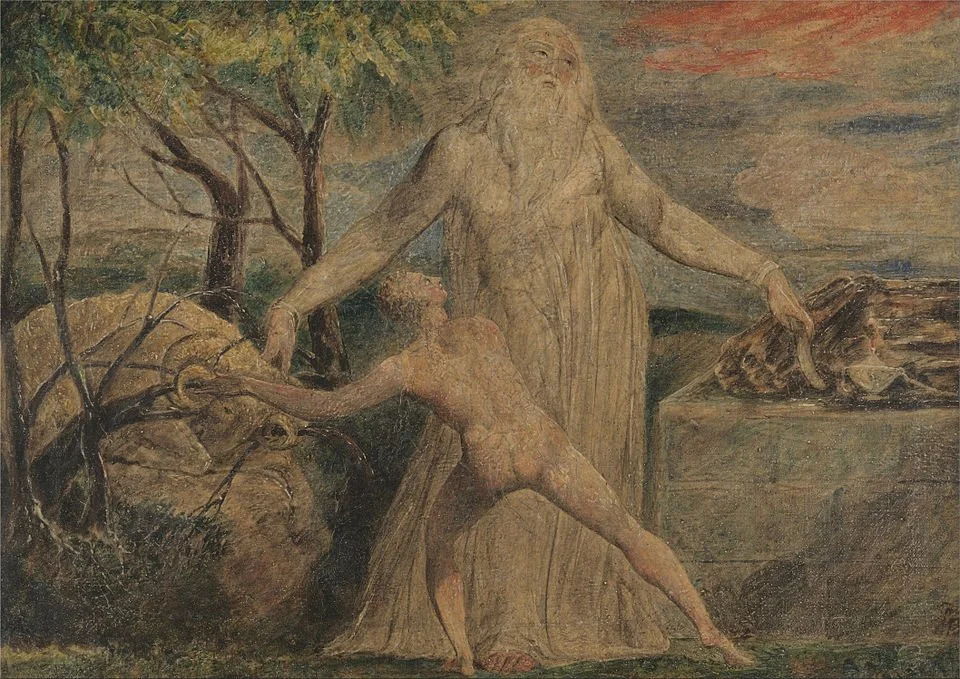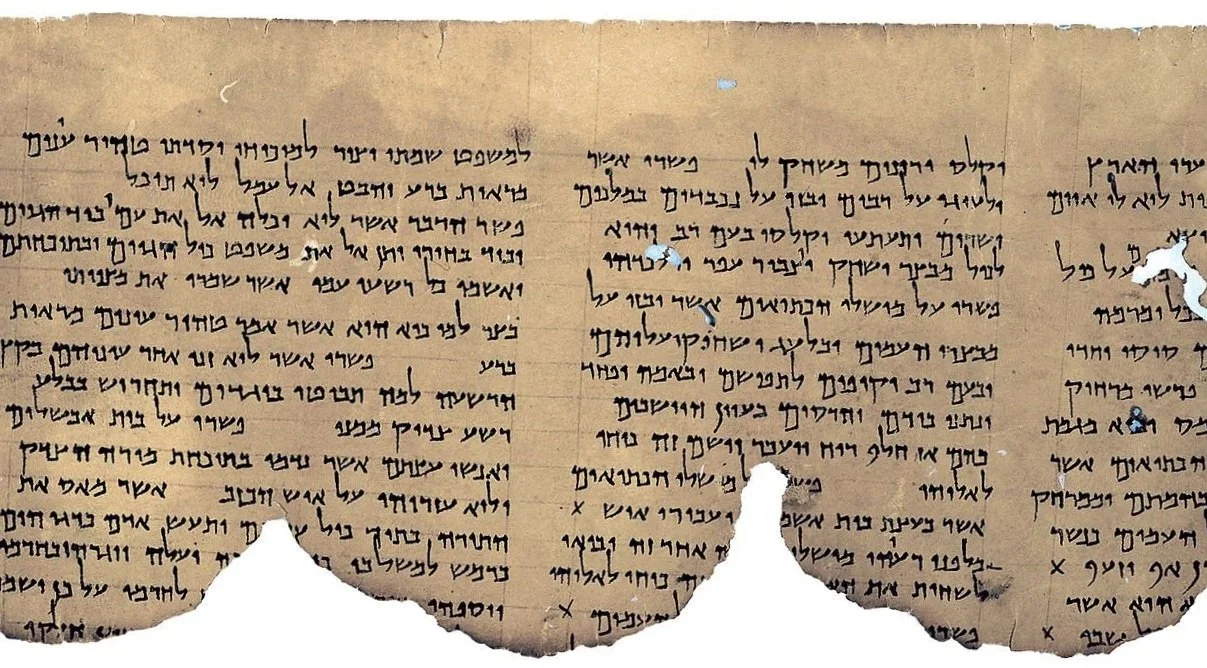This book draws attention to one important but neglected concept from Hellenistic literary criticism that readers—including Christians—used to organize, describe, and evaluate narrative traditions.
Read MoreListening to the Static: An Author Response
Image of Exodus 15, from the Leningrad Codex
Image of Exodus 15, from the Leningrad Codex
The white spaces on the page can be spaces both of death and breath. Both are texts of drowning, the Egyptian enemies, their horses and chariots, and the African slaves, who were thrown overboard the slave ship in an insurance scam. Somehow, I believe, through this unconscious visual echo, these enemies and victims meet in God’s lament to the angels, (though perhaps this lament is addressed to all of us who sing victory songs): “my creations are drowning in the sea, and you are singing song?”
Read MoreWeak Prophecy As A Critique of Just-So Secularization Stories
William Blake, Abraham and Isaac, 1799-1800
William Blake, Abraham and Isaac, 1799-1800
In the book’s conclusion, Raz offers weak prophecy as an alternative, reparative model, offering us doubt and circumspection instead of confident certainty, whether theological or nationalist. I would also suggest a second, complementary payoff. To me, the positing of an ancient source that is dogmatic, masculine, and assertively authoritative is one of modernity’s favorite alibis for its own violence.
Read MoreModern Mirrors
Mirror Detail from the Arnolfini Portrait, Jan van Eyck, 1434. Image Courtesy of Wikimedia Commons.
Mirror Detail from the Arnolfini Portrait, Jan van Eyck, 1434. Image Courtesy of Wikimedia Commons.
We gather from here that more than she wants to say something about prophecy, Raz wants to convey something about the history of its reception, about the way modern poets, and perhaps moderns, in general, think about prophets and prophecy and incorporate that thought into their poetry, utilizing poetic language or the characters of prophets.
Read More"Language of the Limp and the Wound"
William Blake Richmond, Song of Miriam, 1880. Image courtesy of Wikimedia Commons.
William Blake Richmond, Song of Miriam, 1880. Image courtesy of Wikimedia Commons.
With Yosefa’s book, we now have nuanced poetic language with which we may read this homily. The Rabbis were not prophets, nor singers or poets. They were strong readers. They saw reading as an opportunity to stretch out biblical scenes into their present.
Read MorePublication Preview | Exploring the Violent Imaginary of the Dead Sea Scrolls
Alex P. Jassen previews his new book exploring the diverse ways social contestation and violence was perceived and imagined by the Dead Sea Scrolls Sectarians.
Read MoreApocalyptic Masculinity
To expand thinking around performance and apocalypse, my project incorporates a consideration of gender to these categories. So, in this project, I am concerned with answering the question “is there such a thing as apocalyptic masculinity?”
Read MoreThe Hellenistic Context of the Aramaic Dead Sea Scrolls
The Aramaic Dead Sea Scrolls display an overwhelming interest in the Israelite priesthood, sacrificial cult, and Jerusalem temple. A look at the Aramaic Levi Document reveals that this interest may have to do with the shifting fortunes of the priesthood in the third century BCE.
Read MoreHidden No More: Women in the Parables of Luke
In this study a sustained, interdisciplinary argument is offered for the presence of women in parables where they are not named or explicitly described.
Read MorePublication Preview | The Rabbinic Past in the Medieval Islamic World
The understanding that Jews engaged with a full sweep of Islamic sciences was arguably one of the earliest insights of modern Jewish historiography; indeed, medieval Jews were sometimes explicit about turning to non-Jewish sources. But scholarship has traditionally highlighted Jewish engagement with the larger world in fields other than law, such as poetry, theology, and linguistics. Building on the work of others, After Revelation recognizes that medieval Jews and Muslims structured their traditions in similar ways.
Read MoreAwakening Awareness of the Body
May conversations such as these prompt experiences of embodied connection, even across digital spaces, and help us to recover a bodily awareness so often buried beneath reams of paper. May we be mindful of the care and feeding not only of the prophet (and sometimes the deity), but also of the scholar, the student, the writer, and the reader.
Read MoreArt as Text: When Mary Was Lazarus’s Sole Sister
The question of how many sisters were portrayed with Jesus at the Raising of Lazarus in early Christian art has not previously been explored, and interestingly, the hypothesis that Martha was added later aligns with the number of sisters portrayed in early art of the Raising of Lazarus.
Read MoreProphetic Mediation and Ritual Practice
Scenting a space with anointing oil and incense, creates a sensory experience of fragrant divine presence, burning a sacrifice on an alter creates the perception of a divine receiver, veiling and obscuring a sanctuary’s adyton creates a perception of an inhabitant etc.
Read MoreThe Decolonial Prophetic Body
The task ahead in repairing the violence done by the dualistic mind/body hierarchy—and especially the notion of some bodies and their worth as superior/inferior—is not simply an individual task, but a communal one. Indeed, the notion of text as embodied creates not only new avenues of research but also a deep responsibility to the communities who hold these texts as sacred.
Read MoreProphetic Bodies in the Ancient Near East
The prophet mediates or “incarnates” divine emotions, serving as their bodily representative; in other words, the prophetic body becomes the site of the bodily prophecy.
Read MoreWhose Body Is It Anyway: A Response to The Prophetic Body
So, if they are characters who may or may not replicate the experiences of a tangible historical person, then do they have a body? Are their imagined or projected bodies actual bodies that can be psychoanalyzed or engaged as if they were human? Is a character’s fictional embodiment part of its function as avatar for the audience?
Read MoreTowards Divine Embodiment and Biblical Animism: A Review and Suggestion for Anathea Portier-Young’s The Prophetic Body
I wish to engage in an enthusiastic nudge for Portier-Young to continue to explore in subsequent volumes a theme that I consider to be one of most original insights of the book. This is the claim that the divine is sometimes represented in biblical prophetic as embodied, whether a parallel fashion with the prophetic body, or as a reciprocal intertwining with the dynamically transforming prophetic body (esp. Portier-Young 2024, 57-58).
Read MoreThe Prophetic Body: A 2024 SBL Review Panel
SBL Review Panel for Anathea Portier-Young’s The Prophetic Body: Emodiment and Mediation in Biblical Prophetic Literature
Co-Sponsored by the Religious Experience in Antiquity and Senses, Cultures, and Biblical Worlds Program Units of the Society of Biblical Literature
November 23, 2024
The Case for Retraction of Academic Authentications of Forged Fragments
This position paper issues a call for editors and publishers with oversight over peer-reviewed publications of inauthentic post-2002 Dead Sea Scroll-like fragments to embark on the processes that would consider (and likely result in) retraction. By common consent, findings in the publications identified in this essay are unreliable at best; many present material subsequently deemed falsified. Retraction is the proper and justified measure to take regarding these publications in order to correct the academic record and alert any and all potential readers to the untrustworthy nature of their content.
Read MoreDivine Names and Numinous Power: Onomastic Tools to Help and Harm
Power in the Name contributes to this growing body of work unbeholden to the myopic strictures of materialism and (more broadly) scientism by comparatively analyzing examples of humans changing their environment (e.g., healing or hurting others) by invoking powerful divine names.
Read More


















